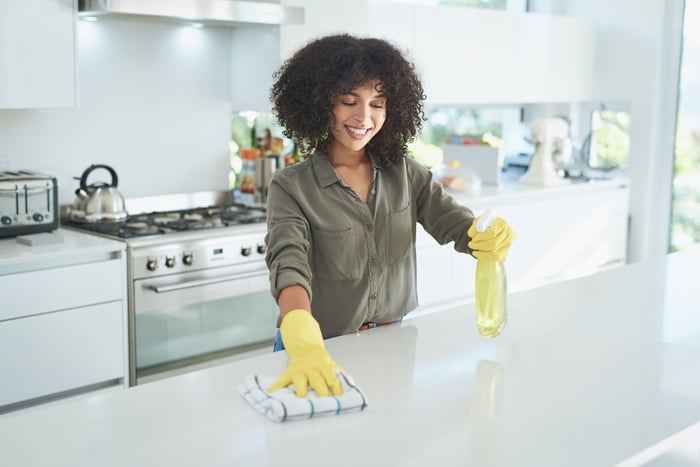Clorox (CLX -0.69%) was a Wall Street darling early in the coronavirus pandemic when consumers were bolstering their cleaning routines. As demand for cleaning products cooled, so did investor enthusiasm around Clorox, with a steep drop in profitability making the situation even worse.
And yet, the core dynamics of the business haven't changed at all, with management continuing to focus on some of the most important words in the consumer staples business: new and improved. Here's what Clorox is doing -- and how it should be good for investors.
Building out a business
Clorox's business got caught up in the pandemic because it has a lot of cleaning products, headlined by its namesake brand. The company didn't sit idle during this unusual period. It inked deals with contract manufacturers so it could ramp up supply to meet the demand it was seeing in the market. Contract manufacturers are costly, but it was a quick fix that allowed Clorox an easy way to reduce supply when demand finally ebbed. It has since exited these manufacturing deals.

Image source: Getty Images.
There's one more thing the company did, however, that's particularly important to understand. It worked to expand its wipes business while customers were focused on cleaning. Essentially, that brief period of time allowed Clorox to do something with an existing brand and product that might have taken years to achieve without the health scare. And it didn't need to do any innovation to convince customers to try its products.
The pandemic was a difficult period and Clorox shares were hit hard when clean demand cooled off and investor sentiment turned lower. However, the growth in its wipes business was a notable success -- and rather unusual in the consumer staples space. With that in the past, the company has gotten back to normal, which means convincing customers to buy its products. New and improved products are the key to achieving that aim.
A slate of opportunities
One of the ways Clorox differentiates itself is by offering products that are viewed favorably by consumers. The company's internal metric shows that 76% of its portfolio is viewed to have "superior consumer value." A great brand name might be enough to get consumers to buy a product during a pandemic, but it isn't enough to differentiate a product during normal times. So, like other consumer staples makers, Clorox invests in innovation.
As an example, the company has introduced a Clorox branded disinfectant in a bottle that provides a continuous spray. Over the past year or so, this new offering has produced $25 million in sales and, according to Clorox, represents two of the top-five new items in the category. But more importantly, the product has been "35% incremental" to the category. In other words, the disinfectant spray got more customers to buy disinfectant sprays at all.
That's the power of "new and improved" with consumers. And it is why retailers favor partnerships with companies that focus on innovation. In some ways, everybody wins. Clorox sees improved sales and likely margins, too, thanks to higher-cost products. Consumers get to buy what they see as better products. And retailers see increased sales and traffic thanks to the new and improved wares they carry. And this is a potential multi-year effort as the company offers updated versions of the disinfectant, including new scents, among other things.
Clorox is large and diversified, so the disinfectant spray isn't the only thing it has going on right now. It is also bringing out updated versions of its cat litter, Fresh Step. The "outstretch" variation allows customers to stretch the time between litter cleaning. This product had $46 million in sales over the past year and has quickly found itself in the top-five products in the company's clumping litter portfolio with a roughly 50% repeat purchase rate.
The company's Glad bag line has also been bringing out new innovations, this time tying the brand with the Clorox nameplate. The innovation has resulted in $120 million in sales and a 36% repeat purchase rate. This mash-up concept has been extended this year, with Pine-Sol, with more extensions likely in the future.
In the DNA
The above examples are notable for the success they have achieved, which is why management wants investors to know about them. But the real story here is that Clorox is always working on ideas like these to help support long-term growth. It is just the way the company operates, which is important today and will remain important well into the future in what is a highly competitive industry.
Investors looking at consumer staples companies should focus on product innovation, favoring companies that have a history of introducing successful products. Clorox's current round of examples is just the most recent show of strength from the company when it comes to those all-important words, "new and improved."
These types of products are what will power the company forward as it works back from the pandemic fallout and inflationary pressures, because such innovation will allow the company to justify charging higher prices. And as margins improve, investors will likely view the stock more favorably.





